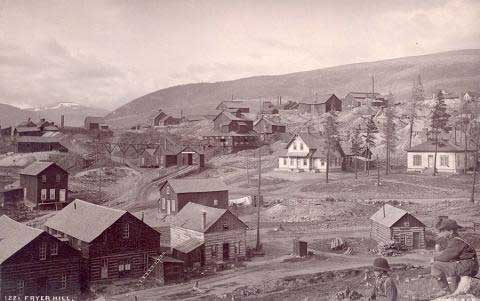Eagle County Colorado GenWeb
COGenWeb a proud partner of USGenWeb
Eagle County Colorado
 As of 2020, Eagle County's population was 55,731, with Eagle as the county seat, but Edwards is the largest community. And Vail is its most popular town.
Named for the Eagle River that runs through it, Eagle County was formed by the Colorado legislature in 1883 from sections of Summit County. Rich with trails, byways, and protected forests and wilderness areas, much of Eagle County is comprised of the White River National Forest. The Bureau of Land Management (BLM) oversees much of the remainder of the land
As of 2020, Eagle County's population was 55,731, with Eagle as the county seat, but Edwards is the largest community. And Vail is its most popular town.
Named for the Eagle River that runs through it, Eagle County was formed by the Colorado legislature in 1883 from sections of Summit County. Rich with trails, byways, and protected forests and wilderness areas, much of Eagle County is comprised of the White River National Forest. The Bureau of Land Management (BLM) oversees much of the remainder of the land
The Leadville strike of 1880 was the first major labor conflict in the central Colorado silver boomtown, shutting down most of the area's mining district from May 26 to mid-June as miners pressed owners and managers for higher wages, an eight-hour workday, and more control over their working conditions. Owners and managers successfully resisted workers' demands until a local citizens' committee convinced Governor Frederick Pitkin to send in military support to get the mines reopened. The unsuccessful strike helped mark Leadville's shift from boomtown to stable city as miners accepted existing power relations after their failure. The city went more than fifteen years before its next major labor conflict.
 The lead carbonate strike in Leadville in 1874 brought many prospectors to the valley which became Eagle County. By 1879 a permanent camp was established and became the town of Redcliff. Eagle county was formed in 1883 from Summit County. The original county seat was Redcliff. The county seat moved to the town of Eagle in 1921.
Eagle county is located in the Rocky Mountains to the west of Denver. I-70 runs east-west through the middle of the county. Once dependent upon mining and agriculture, today's economy is driven by tourism. The Vail and Beaver Creek ski resorts are located in Eagle County. The evolution of Vail into an international resort is credited to the famous 10th Mountain Division ski troops who were introduced to the valley while training at Camp Hale in the 1940s. Following World War II, a group of former Army buddies returned and developed a ski resort, Vail.
Eagle County includes the towns of Vail, Avon, Edwards, Minturn, Eagle, Gypsum, Dotsero and Basalt, CO
In 1995, Eagle County had a population of 28,844. In 2015 Eagle County had a population of 53,605
The lead carbonate strike in Leadville in 1874 brought many prospectors to the valley which became Eagle County. By 1879 a permanent camp was established and became the town of Redcliff. Eagle county was formed in 1883 from Summit County. The original county seat was Redcliff. The county seat moved to the town of Eagle in 1921.
Eagle county is located in the Rocky Mountains to the west of Denver. I-70 runs east-west through the middle of the county. Once dependent upon mining and agriculture, today's economy is driven by tourism. The Vail and Beaver Creek ski resorts are located in Eagle County. The evolution of Vail into an international resort is credited to the famous 10th Mountain Division ski troops who were introduced to the valley while training at Camp Hale in the 1940s. Following World War II, a group of former Army buddies returned and developed a ski resort, Vail.
Eagle County includes the towns of Vail, Avon, Edwards, Minturn, Eagle, Gypsum, Dotsero and Basalt, CO
In 1995, Eagle County had a population of 28,844. In 2015 Eagle County had a population of 53,605
Sugar Beet Industry
Today sugar beet production is a small part of Colorado's economy, but in the twentieth century it was the most important agricultural activity in the state. Of more than twenty sugar-refining factories, most built between 1899 and 1920, only the Fort Morgan factory remains in operation. In recent years, the US Environmental Protection Agency has provided financial assistance to former "sugar towns" to clean up deserted factory grounds contaminated with asbestos and decades' worth of lime waste. The sugar beet industry's importance to Colorado history extends beyond these ruins.
County Coordinator: Betty Baker
State Coordinator: Colleen Pustola
Assist. State Coordinators:
Rebecca Maloney
Betty Baker
M.D. Monk
This page was
Camp Hale
In March 1942 the US Army chose the Pando Valley as the site for Camp Hale, where some 15,000 soldiers would train for high-altitude winter combat during World War II.
By November the entire camp was complete, and the Tenth Mountain Division and other units began training that winter. The division served admirably in Italy during the winter of 1944/45, breaking the German line across the Apennine Mountains. After the war many veterans of the Tenth returned to Colorado to build the modern ski industry. In 1965 the army transferred the former site of Camp Hale to the White River National Forest.
More Info **NEW**